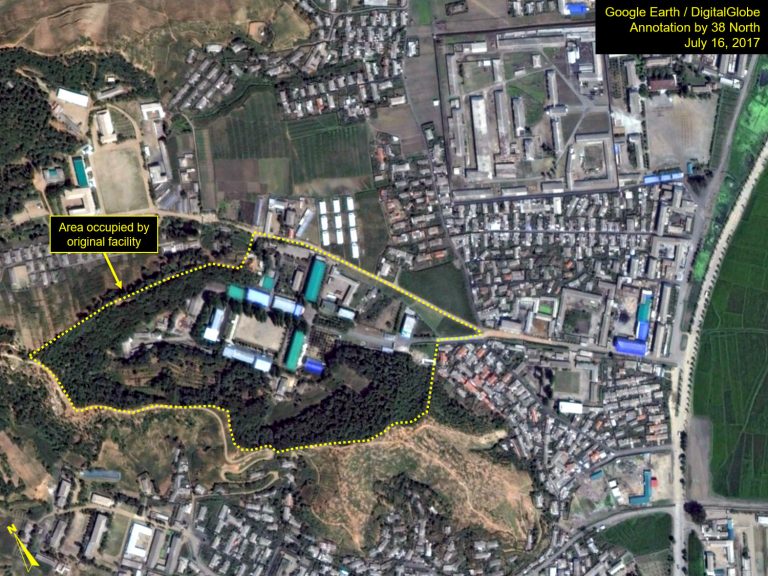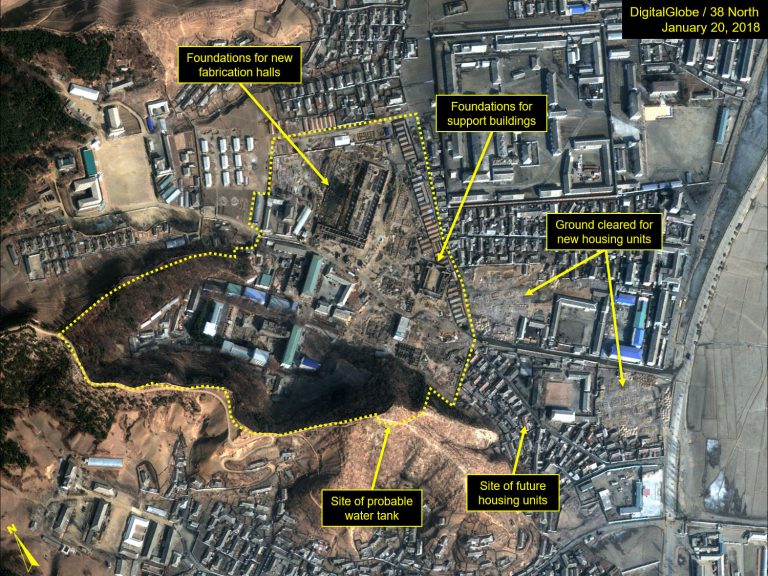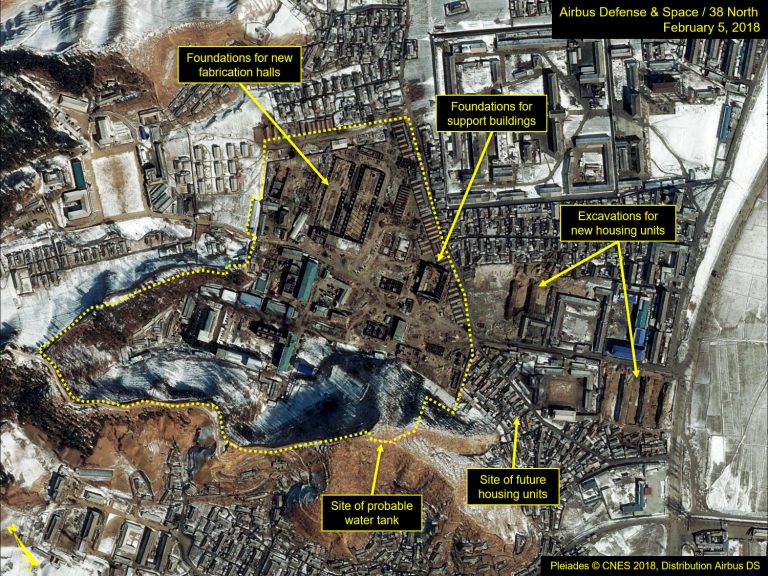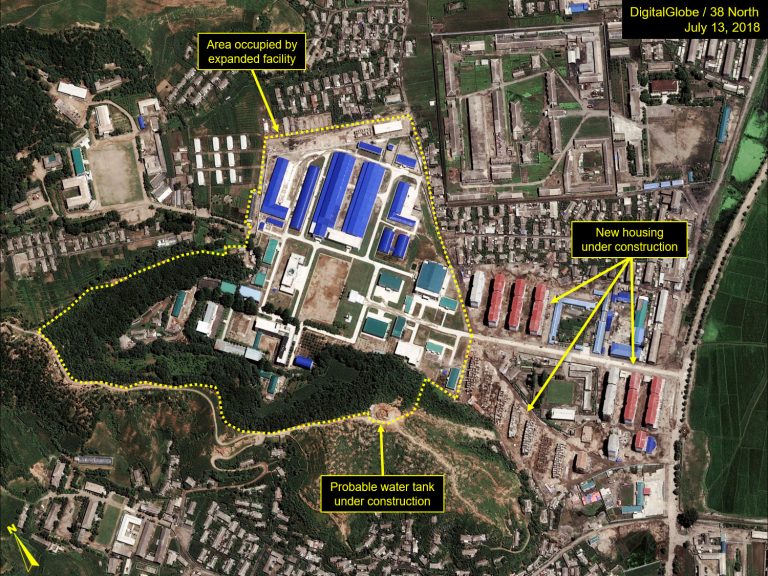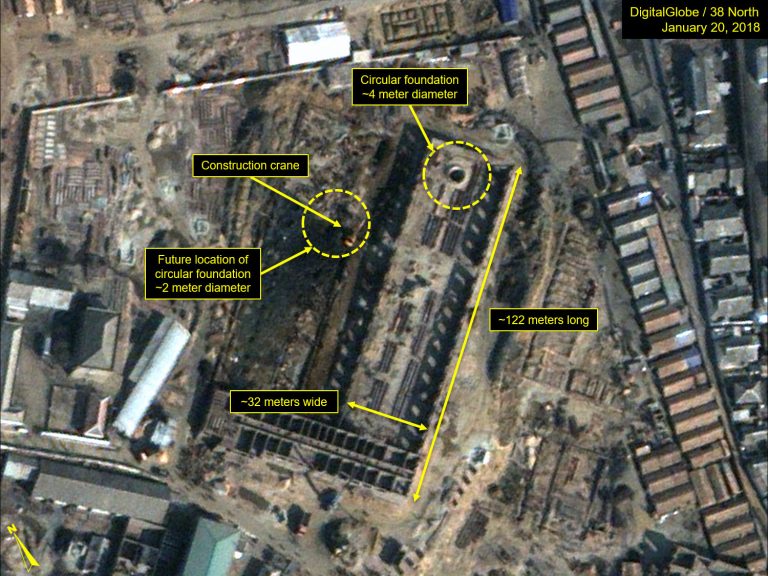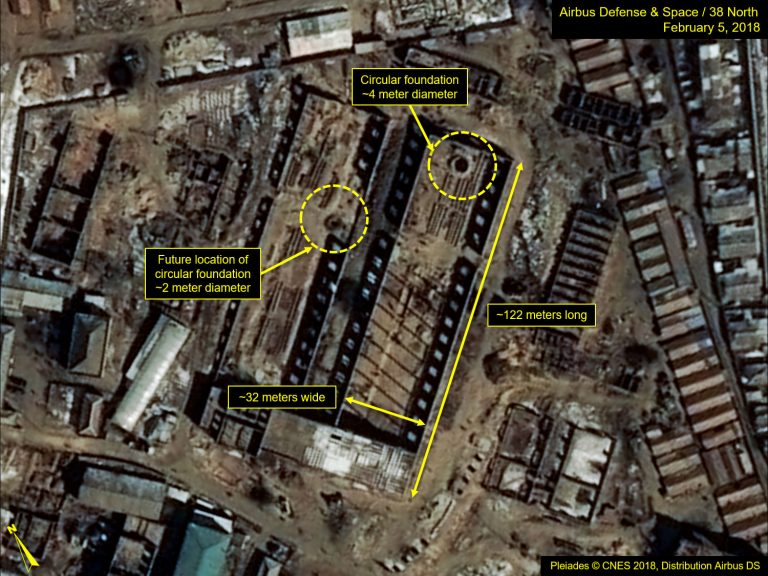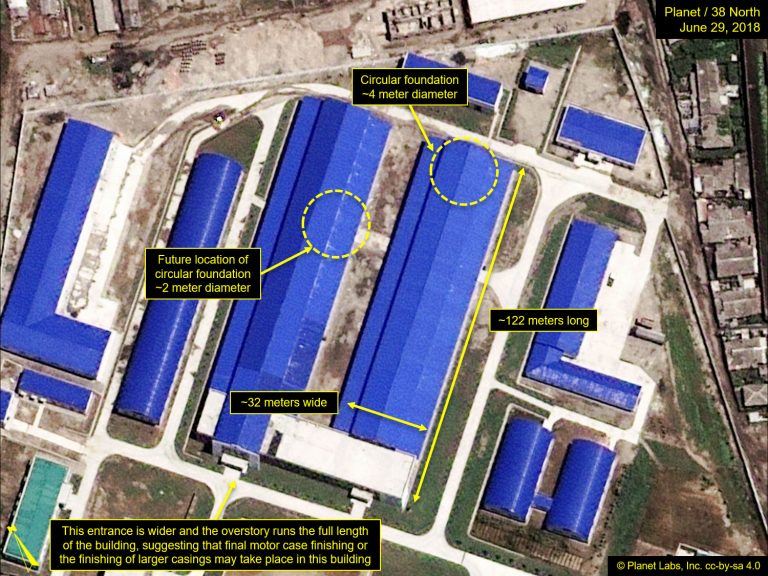Expansion of North Korea’s Solid Fuel Ballistic Missile Program: The Eight Year Old Case of the Chemical Materials Institute
While recent press reports have focused on the expansion of North Korea’s Chemical Materials Institute (CMI)[1]—a key facility in its production of solid-rocket motors for missiles—in the months leading up to and in the aftermath of the US-DPRK summit, these efforts have actually been ongoing for at least the past eight years. This activity indicates that the North is continuing to expand its production capabilities to produce solid rocket motors for the Pukguksong-1 and -2 and potentially the -3 and beyond. The Pukguksong-1 submarine-launched ballistic missile (SLBM) began testing in 2016 and the Pukguksong-2 medium-range ballistic missile (MRBM) began testing the following year, but both presumably have now halted as part of the DPRK’s moratorium on nuclear and ballistic missile testing. Although the institute has been described as a “missile manufacturing plant,” CMI only produces several sub-components of those missiles and is only part of the North’s broader long-term program to develop and expand its solid-fuel ballistic missile production capabilities and underlying infrastructure.
Organization
Established in the 1970s, CMI has been responsible for a wide variety of practical research and development projects on various materials for industrial applications in such areas as chemicals, fertilizers, machinery, mining, plastics, telecommunications, transport and defense. Since the 1990s, it has concurrently been engaged in a number of research and development projects for the North’s space and ballistic missile programs. Since at least 2010, one of those projects has been the research and development of filament-wound rocket motor casings for ballistic missiles. In late 2017, this responsibility was moved from the research and development phase into the establishment of a production facility for these casings. As of mid-July 2018, the new production facility is externally complete but does not yet appear to be operational.
The serial production of these casings—from which solid rocket motors are manufactured—will allow North Korea to deploy increased numbers of solid-fuel ballistic missiles. Such systems will likely be more capable and survivable than the numerous liquid-fuel Scud-based systems currently in the Korean People’s Army (KPA) service.
As best as we can determine, North Korea’s solid rocket motor research, test, development and production infrastructure is primarily centered in the general Hamhung-Hungnam area, with several factories and research institutes elsewhere in the nation supporting it. These facilities include the:
- Chemical Materials Institute
- February 8 Vinalon Complex[2]
- Hungnam Fertilizer Complex
- Magunpo Solid Rocket Motor Test Facility
- No. 17 Explosives Factory[3]
- Pongung Chemical Plant
CMI’s Role in the DPRK Missile Program
It is unclear when CMI became involved in the North’s solid-fueled ballistic missile program but this may date back to the KN-02 Toksa (a North Korean variant of the Russian OTR-21 Tochka [SS-21]) program during the late 1990s-early 2000s.[3] During 2010-2012, the institute appears to have become involved with the new Pukguksong-1 (KN-11) submarine-launched ballistic missile (SLBM) program and the development of the solid rocket motor. This work was logically extended to the Pukguksong-2 (a land-based version of the Pukguksong-1) and will apparently include the nascent Pukguksong-3 and beyond.
While the precise details are not entirely clear, it is likely that during 2010-2012, the role of CMI was extended to include the development of large filament-wound rocket motor casings for ballistic missiles. During 2013-2014, the institute is believed to have begun producing these casings in very limited prototype numbers. This likely progressed to pre-production during 2015-2016 and by 2017, it appears that the technology and experience reached the point where it could begin moving into the serial production phase. Although the institute as a research facility lacked the physical infrastructure or manufacturing personnel to undertake full production of filament-wound rocket motor casings, it is where the expertise and equipment to produce the casings resided. The decision was therefore made to reorganize the institute and construct a production facility. It is unclear whether this new facility is organizationally subordinate to CMI or a distinct new organization that is simply collocated with the institute so that the latter can provide support. Given North Korean statements and known infrastructure development practices, the new factory and associated infrastructure has additional missile-related responsibilities (e.g., carbon-carbon production, etc.) besides the production of rocket motor casings.[4]
Construction
While planning and design of a new filament-wound rocket motor casing production factory likely began by early 2017, it only became public knowledge in August 2017 when North Korean media reported on a visit to CMI by Kim Jong Un.[5] It was during this visit that he reviewed the plans and gave final approval for construction of the new factory. It was also during this visit that the first public indications of the development of the multistage Pukguksong-3 were revealed on a display behind Kim. Another display showed “4D carbon-carbon manufacturing process” and indicated that it could be used for missile components such as nose cones and exhaust nozzles. The following images are from Kim’s visit to the Chemical Materials Institute, released on August 23, 2017.
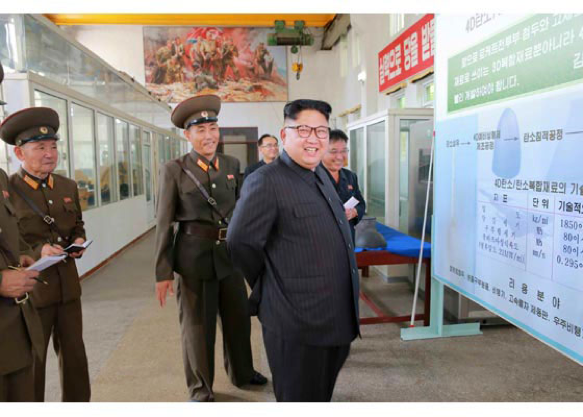
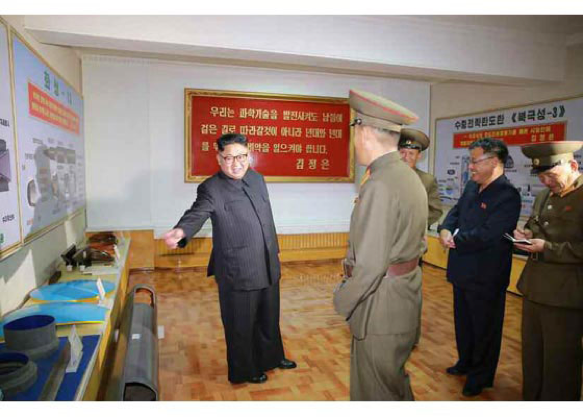
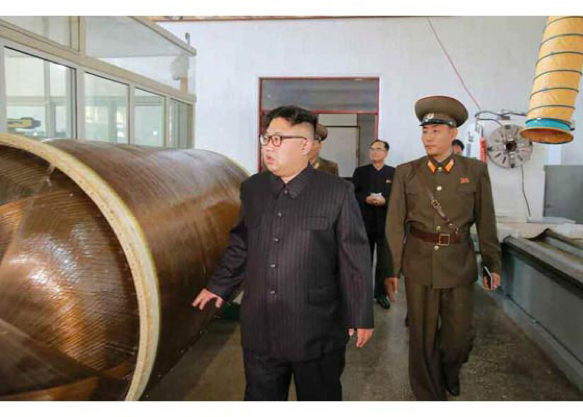
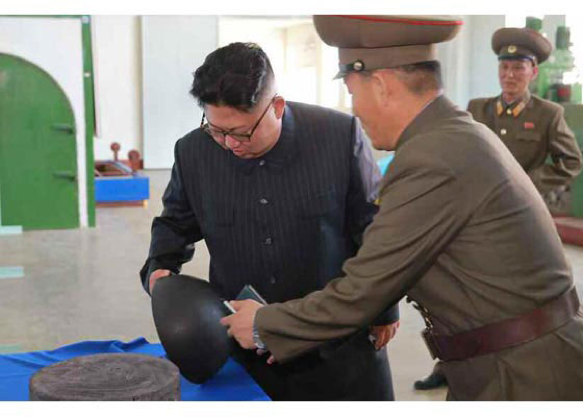
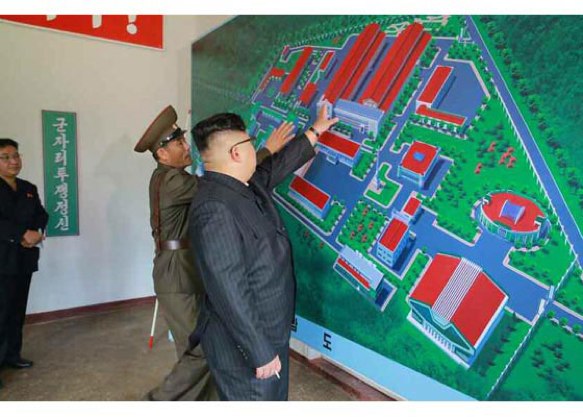
Construction of the new factory began in September-October 2017 with the razing of numerous small housing units east and southeast of the institute’s existing facility. By November 4, 2017, the ground had been almost scraped clear and numerous temporary housing and storage units installed. Commercial satellite imagery from January 20 and February 5, 2018, show the foundations and walls of two large (approximately 122-meters-by-32-meters, including the attached office/engineering building) fabrication halls and several office and support buildings. This imagery shows some unique features that appear to be related to testing or finishing solid motor case production. Among these is a circular foundation in the southern fabrication building that measures (approximately 4 meters-in-diameter, interior dimension) and surrounds an excavation of undetermined depth. This foundation is at the northern end of the building and centered between the wall stanchions in such a way that an overhead crane could be positioned directly above it, perhaps to raise or lower a casing into the excavated area.
The intended purpose of this excavation is unclear. One suggested purpose would be to fulfill a requirement for pressure testing, degreasing, or coating filament-wound rocket motor casings prior to being filled.[6] Alternately, if this pit is intended for hydro-pressure testing—during which the pressure is slowly increased until the case fails—it would require a dome or heavy lid to keep it sealed during testing. Such testing is, however, dangerous and typically conducted outdoors by almost all nations. The North Koreans may accept such risks to reduce any observable signatures of production. In either of these cases the excavation would need to be deep and wide enough to accommodate all sizes of currently planned casings as well as those planned for future manufacture. A third possibility is that this large foundation is a race ring for a turntable, though its location near the end of the building and the apparent excavation makes that less likely. A second smaller (approximately 2-meters-in-diameter, interior dimensions) foundation is located halfway along the northern fabrication building and along the east wall. The purpose of this foundation is unclear.
Figure 1. Expansion of the Chemical Materials Institute from July 2017–July 2018.
Figure 2. Close-up of the fabrication hall construction from January–June 2018.
Imagery from July 13, 2018, shows that the expanded facility now occupies approximately 17.7 hectares (up from 11.3 hectares of the original institute). The new factory is externally complete and while not an exact match of the plans shown to Kim Jong Un during his August 2017 visit, it comes remarkably close. Approximately ten of the institute’s original buildings and several surrounding structures were razed and 24 new buildings erected. The numerous temporary housing and storage units previously present have been removed.
This imagery also shows at least 17 large multi-story apartment buildings in various stages of construction in areas to the southeast of the institute. Given their proximity to the new factory, the timing of their construction, and the absence of other construction in this area of Hamhung, it is likely that they are for workers and their families at the newly constructed factory.
Production and Distribution
When finished and operational, the filament-wound rocket motor casings produced by CMI will likely be transported to the No. 17 Explosives Factory for filling at its new mixing/casting plant.[7] The chemical ingredients for the solid rocket fuel itself are primarily received from several facilities including the nearby February 8 Vinalon Complex, Hungnam Fertilizer Complex and Pongung Chemical Plant. Upon completion of the mixing, casting and curing process, the finished solid rocket motor will either be transported to a storage facility or directly to an assembly facility for final manufacturing of a ballistic missile. Finished ballistic missiles are then transported to Strategic Force storage facilities located around the nation. From these sites, they are distributed to operational units as required.[8] The nearby Magunpo Solid Rocket Motor Test Facility—located 3.5 km southwest of the No. 17 Explosives Factory—will likely be used for quality control and the testing of new solid rocket motor designs.[9]
- [1]
A cursory look at the Chemical Materials Institute was reported by the Wall Street Journal on July 1, 2018 (https://www.wsj.com/articles/north-korea-expands-key-missile-manufacturing-plant-1530486907) based on a report authored by Jeffrey Lewis and Dave Schmerler on Arms Control Wonk https://www.armscontrolwonk.com/archive/1205558/north-korea-expanding-key-missile-site/. Information on this facility has been publicly available since at least the late 1990s.
- [2]
Sometimes identified as the “2.8 Vinylon Complex,” or “Sinhung Chemical Complex.” Joseph S. Bermudez Jr., Michael Elleman and Curtis Melvin, “UDMH Production in North Korea: Additional Facilities Likely,” 38 North, October 25, 2017, https://www.38north.org/2017/10/udmh102517/; Jeffrey Lewis, “Domestic UDMH Production in the DPRK,” Arms Control Wonk, September 27, 2017, http://www.armscontrolwonk.com/archive/1204170/domestic-udmh-production-in-the-dprk/.
- [3]
The No. 17 Explosives Factory was covered in the second installment of this series on North Korea’s solid rocket motor infrastructure. See, “North Korea’s Solid-propellant Rocket Engine Production Infrastructure: The No. 17 Factory in Hamhung,” 38 North, January 30, 2018, https://www.38north.org/2018/01/no17factory180130/.
- [4]
Interview data; Joseph S. Bermudez Jr., “The KN-02 SRBM in KPA Service,” KPA Journal 1, no. 2 (February 2010): 7-13.
- [5]
Interview data. The chronology presented here, while the best presently available, should be viewed as tentative and will likely change as new information becomes available in the future.
- [6]
Michael Elleman, “Kim’s Visit to the Chemical Material Institute: A Peek into North Korea’s Missile Future,” 38 North, August 25, 2017, https://www.38north.org/2017/08/melleman082517/; “Kim Jong Un Inspects Chemical Material Institute of Academy of Defense Science,” Rodong Sinmun, August 23, 2017.
- [7]
The specifics of North Korean practices for doing this are unknown but probably include at least once for each stage of a system, and possibly one of every batch.
- [8]
“North Korea’s Solid-propellant Rocket Engine Production Infrastructure: The No. 17 Factory in Hamhung,” 38 North, January 30, 2018, https://www.38north.org/2018/01/no17factory180130/; Midterm Report of the Panel of Experts Submitted Pursuant to Resolution 2345, New York: United Nations, September 17, 2017, p. 9/111 to 11/111 and Annex 5.
- [9]
Interview data.
- [10]
The Magunpo Solid Rocket Motor Test Facility was covered in the first installment of this series on North Korea’s solid rocket motor infrastructure. See, Joseph S. Bermudez Jr., “North Korea’s Ballistic Missile Infrastructure—What Does it Mean for the Future?” 38 North, May 2, 2017, https://www.38north.org/2017/05/missile050217/; Joseph S. Bermudez Jr., “Did North Korea Conduct A Solid-Fuel Rocket Engine Test at Magunpo?” 38 North, November 13, 2017, https://www.38north.org/2017/11/jbermudez111317/; and Joseph S. Bermudez Jr., “Quick Takes: No Signs of Recent Tests at the Magunpo Engine Test Facility,” 38 North, January 19, 2018, https://www.38north.org/2018/01/magunpo011918/.

